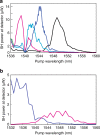Large second harmonic generation enhancement in Si3N4 waveguides by all-optically induced quasi-phase-matching
- PMID: 29044113
- PMCID: PMC5725590
- DOI: 10.1038/s41467-017-01110-5
Large second harmonic generation enhancement in Si3N4 waveguides by all-optically induced quasi-phase-matching
Abstract
Efficient second harmonic generation in integrated platforms is usually achieved by resonant structures, intermodal phase-matching or quasi-phase matching by periodically poling ferroelectric waveguides. However, in all these structures, it is impossible to reconfigure the phase-matching condition in an all-optical way. Here, we demonstrate that a Watt-level laser causes a periodic modification of the second-order susceptibility in a silicon nitride waveguide, allowing for quasi-phase-matching between the pump and second harmonic modes for arbitrary wavelengths inside the erbium band. The grating is long-term inscribed, and leads to a second harmonic generation enhancement of more than 30 dB. We estimate a χ (2) on the order of 0.3 pm/V, with a maximum conversion efficiency of 0.05% W-1. We explain the observed phenomenon with the coherent photogalvanic effect model, which correctly agrees with the retrieved experimental parameters.
Conflict of interest statement
The authors declare no competing financial interests.
Figures




References
-
- Leuthold J, Koos C, Freude W. Nonlinear silicon photonics. Nat. Photonics. 2010;4:535–544. doi: 10.1038/nphoton.2010.185. - DOI
-
- Moss DJ, Morandotti R, Gaeta AL, Lipson M. New CMOS-compatible platforms based on silicon nitride and Hydex for nonlinear optics. Nat. Photonics. 2013;7:597–607. doi: 10.1038/nphoton.2013.183. - DOI
-
- Tanzilli S, Riedmatten H, De, Zbinden H. Highly efficient photon-pair source using periodically poled lithium niobate waveguide. Electron. Lett. 2001;37:26–28. doi: 10.1049/el:20010009. - DOI
Publication types
Grants and funding
LinkOut - more resources
Full Text Sources
Other Literature Sources
Miscellaneous

